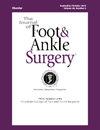足底跟骨刺切除对足底筋膜手术效果的影响。
IF 1.3
4区 医学
Q2 Medicine
引用次数: 0
摘要
足底跟痛是一种影响10%人口的普遍疾病,足底筋膜炎是最常见的原因。足底跟骨刺常与足底筋膜炎相关,但其在病情和手术结果中的作用尚不清楚。本研究利用射频微肌腱切开术和骨髓抽吸技术,探讨足底跟骨刺切除对足底筋膜手术结果的影响。回顾性分析了136例足底筋膜手术83例,其中包括足底跟骨刺切除。分析人口学因素和手术因素。结果包括穿鞋负重的时间、症状缓解和并发症。足底跟骨刺切除与症状缓解延迟(p = 0.006)和穿鞋负重时间(p = 0.020)相关。在手术侧边方面,观察到有统计学意义的差异,与左侧手术相比,右侧手术显示出症状缓解所需的时间增加(p = 0.007),复治率更高(p = 0.017)。手术组和非手术组在并发症发生率和再治疗需求方面无显著差异。这些发现强调在足底筋膜炎的手术计划中需要仔细考虑足底跟骨刺切除,这对患者教育和管理策略具有重要意义。本文章由计算机程序翻译,如有差异,请以英文原文为准。
The effect of plantar calcaneal spur excision on plantar fascia surgery outcomes
Plantar heel pain is a prevalent condition affecting 10 % of the population, with plantar fasciitis being the most common cause. Plantar calcaneal spurs are frequently associated with plantar fasciitis, yet their role in the condition and surgical outcomes remains unclear. This study investigates the impact of plantar calcaneal spur excision on the outcomes of plantar fascia surgery, utilizing a radiofrequency microtenotomy and bone marrow aspiration technique. A retrospective review of 136 plantar fascia surgeries was conducted with 83 cases including plantar calcaneal spur excision. Demographic and operative factors were analyzed. Outcomes included time to weight-bearing in a boot and shoes, symptom resolution, and complications. Plantar calcaneal spur excision was associated with a statistically significant delay in symptom resolution (p = 0.006) and time to weight-bearing in shoes (p = 0.020). A statistically significant difference was observed regarding operative laterality, with right-sided surgeries demonstrating an increased time to symptom resolution (p = 0.007) and a higher retreatment rate (p = 0.017) compared to left-sided surgeries. There was no significant difference in complication rates or the need for retreatment between excision and non-excision groups. These findings highlight the need for careful consideration of plantar calcaneal spur excision in surgical planning for plantar fasciitis, with implications for patient education and management strategies.
求助全文
通过发布文献求助,成功后即可免费获取论文全文。
去求助
来源期刊

Journal of Foot & Ankle Surgery
ORTHOPEDICS-SURGERY
CiteScore
2.30
自引率
7.70%
发文量
234
审稿时长
29.8 weeks
期刊介绍:
The Journal of Foot & Ankle Surgery is the leading source for original, clinically-focused articles on the surgical and medical management of the foot and ankle. Each bi-monthly, peer-reviewed issue addresses relevant topics to the profession, such as: adult reconstruction of the forefoot; adult reconstruction of the hindfoot and ankle; diabetes; medicine/rheumatology; pediatrics; research; sports medicine; trauma; and tumors.
 求助内容:
求助内容: 应助结果提醒方式:
应助结果提醒方式:


